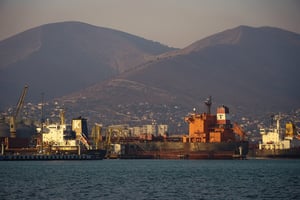MARITIME TRANSPORT: FUELS, EMISSIONS AND SUSTAINABILITY WHITE PAPER
Carbon Reduction Scientists, Nathan Wood, Dr Robert Moorcroft and Dr Torill Bigg have written our ‘Maritime Transport: Fuels, Emissions and Sustainability’ white paper. Read the white paper below.
.jpg?width=300&name=Tunley%20Headshots%20(17).jpg)
-1-1.jpg?width=300&name=Tunley%20Headshots%20(2)-1-1.jpg)
-1.jpg?width=300&name=Tunley%20Headshots%20(13)-1.jpg)
ABSTRACT
The maritime shipping industry is a key economic driving-force of the world economy. Current generation ships are heavily reliant on fossil fuels, further compounded by their use in port and docking equipment. The use of fossil fuels presents a hazard to communities surrounding ports through the release of air pollutants and contributing to global warming. This white paper explores the fuels used within shipping, their respective environmental impact and health implications thereof. We discuss alternative fuels, their environmental impact and comparison to current fuels. We then assess the fuel efficiency effects of biofouling and propose solutions. Finally, we discuss the impact of ports on the environment and possible remediations.
INTRODUCTION
The flow of trade via oceans and waterways has been established since time immemorial, playing a major role in the development of human society. For much of history, ships were propelled by the wind, or human power. The industrial revolution (1750 – 1840 AD) led to advances in knowledge and the creation of steampower. Innovations in steam engines paved the way for the prevalence of steam-propelled ships in the 19th century, fuelled primarily by coal. The combustion of coal is notoriously unclean, producing high levels of COx, NOx, SOx and Particulate Matter (PM) [1]. Driving the prevalence of coal was ease of access, high abundancy and coal is simple to extract from shallow underground workings, or surface outcrops.
As technology developed towards the middle years of the 19th century, crude oil (petroleum) became viable to extract from underground deposits. Distilled petroleum became prized for its multitude of uses, from kerosene to power oil lamps, all the way to its application as a lubricant [2]. Fuel oils became a source of fuel for ships in 1870s, with widespread adoption in the 1960s and is still the predominant fuel to this present day [3].
The maritime transport industry is vital to our present day globalised world, with approximately 90% of traded commodities reliant on shipping [4], [5]. It is estimated that the shipping industry is responsible for 940 MtCO2 per year, approximately 2.5% of global CO2 emissions [6].
An increasing number of regulations and targets are being implemented to reduce the Greenhouse Gas (GHG) emissions produced by shipping. The International Maritime Organization (IMO) has set stringent targets to reduce the carbon footprint of international shipping by at least 40% by 2030, compared to 2008 levels [7]. The 2021 EU Green Deal sets in place targets for a 90% reduction in port city GHG emissions by 2050 [7]. The EU has also publicly declared the need to bring shipping under its Emissions Trading System (ETS) which sets caps on the emissions of companies per annum, with financial implications for companies who breach this limit [7].
The shipping industry is actively moving towards alternative fuels for shipping to reduce its carbon footprint, with many prospective fuel-types [8], [9]. Both Liquid Natural Gas (LNG) and hydrogen are gaining traction as fuels for the future [8]. However, questions arise from these choices surrounding sustainability and reliance on fossil fuels.
Ports also play a dual role in the decarbonisation of shipping, by reducing in-port greenhouse gas emissions, as well as facilitating the reduction of at sea GHG emissions [10]. Rotterdam is Europe’s most polluting port, with an estimated 13.7 million tonnes CO2e per year, more than twice the footprint of an average coal fired power station [11]. With regards seabased emissions, as of April 2018, only 28 out of the 100 largest ports (by cargo) offered incentives for environmentally friendly ships [12]. This clearly indicates that ports have a significant role to play in the decarbonisation of shipping.
In this paper, future fuels for the shipping industry will be compared to current fuels. Furthermore, methods to increase fuel efficiencies, such as hull coatings will also be explored and a brief discussion on the role of ports will take place.


